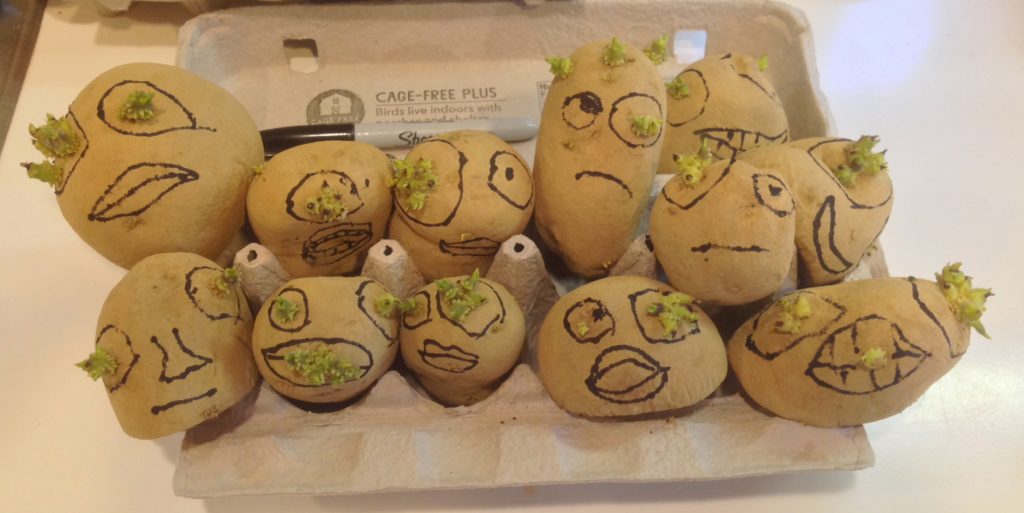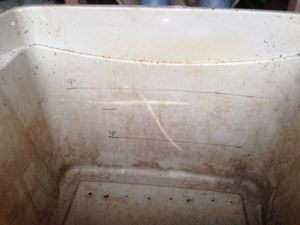 Briefly, here is how I plant potatoes with preschoolers. My preference is to set things up so it is as easy as possible, especially because I’m working with 3-5 year olds.
Briefly, here is how I plant potatoes with preschoolers. My preference is to set things up so it is as easy as possible, especially because I’m working with 3-5 year olds.
I use 18 gallon or larger storage totes. I’ve used Sterlite and they lasted four years before requiring replacement. This model, from Rubbermaid, looks like similar dimensions.
These can often be found free, but if I need to buy, I’ll probably buy Brute models like this, for durability.

I mark the inside of the potato bucket so the kids know where to stop adding soil, and so do I.
Inside I draw two lines and mark them, at 4” and at 9”, as in the photo. (If I were doing it again I’d probably do it at 5” and at 9”, but it doesn’t really matter. These marks have lasted three years now, so nobody needs to ask how deep the soil should be. I also drill a few holes (six or so) in the bottom, as in the photo, for drainage.

Bring potatoes to the party.
- Line the tubs with three sheets of newspaper. This helps maintain moisture but allows for excess water to flow out as necessary.
- I have a fun talk with the kids about how plants grow looking toward the sun with their eyes. They’re also told to be gentle with the potato eyes that are sprouting, the same way you wouldn’t want someone to poke you in the eye, you want to be kind to the potatoes. Kids (and adults, including me), always have a fun time with this.
- Kids fill the tub with soil (mostly or 100% compost) to the 4” mark.
- Kids gently put the seed potatoes in, eyes facing up.

Kids fill the tubs with soil that’s been mixed/moistened in a kiddy pool. Doesn’t need to be moistened, but mud is always fun.
- Kids add soil up to the 9” mark.
After the potatoes have grown about 4”, I add another 2” or so of soil. You can do this again if so inclined and if you’ve got space, but I try to make sure I cover the top with an inch or more of some mulch – I typically prefer shredded leaves but hay, straw or shredded newspaper all work fine.
Containers, any container, will require more frequent watering than potatoes grown in the ground– mulch helps maintain the moisture levels. Take heed though: Potatoes that go through under watering/over watering cycles will often end up with “hollow heart,” an icky cavity in the center of the potato that looks very unappealing, kind of like a potato geode but instead of crystals you find brown crud inside.
WHAT SOIL?: The soil should be heavy on organic matter – that means compost. Most recommendations are for 50/50 or 75/25 compost/peat or coir mix. I happily use 100% compost.
Yes, yes, science says you need the native soil and all. I cannot disprove the science, nor will I attempt to, but growing in 100% compost has yielded equally good results without the hassles of mixing, sourcing materials, etc. It also means that if you’re planting on a cold day, tiny hands don’t need to mix cold soil mixes.
BUYING POTATOES: Using purchased, certified disease free seed potatoes is best. Store-bought potatoes may not sprout due to growth inhibitors that are used even on organic potatoes.
More importantly, potatoes at the store may have been infected with Late Blight, the disease that caused the Irish potato famine. Infected potatoes are fine for human consumption, but if grown they can wipe out not only your potato crop, but your tomato crop, your eggplant crop a few other edible crops AND THEN YOUR NEIGHBOR’S CROP AND THEIR NEIGHBOR’S CROP and so on. Late Blight is transmitted by spores in the wind. Wherever the wind blows, the spores go too. This is why Late Blight typically starts south and west of Massachusetts but the prevailing winds carry it to us.
Kind of late to purchase seed potatoes, but High Mowing Seeds (https://www.highmowingseeds.com/) and the Maine Potato Lady (https://www.mainepotatolady.com) are favorite sources.
WHAT VARIETY: When choosing your variety, consider when you want your potatoes harvested.
Early potatoes will finish off during school summer break. That’s fine, but the kids who planted the potatoes may not be there to harvest. (That may not be an issue.) If you want potatoes that can be harvested by the same kids once school starts again in the fall, choose a long-season or late variety. Keep in mind that in the fall, perhaps before school starts, the plants will wither and die above ground – they’re supposed to do that.
Farmers who are growing their potatoes for long-term storage over the winter will wait for the plants to die back and allow them to sit for two weeks longer. In the case of a school gardener, the timing may be less important but once the potatoes have died back, try to keep them dry. Moving them to a shed, under a tarp or something similar should do the trick.
